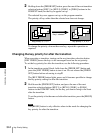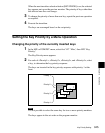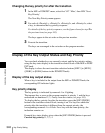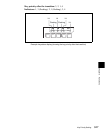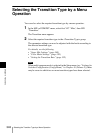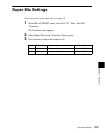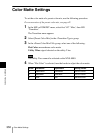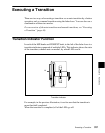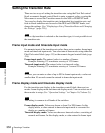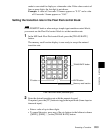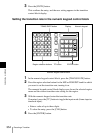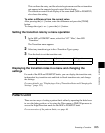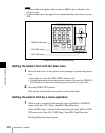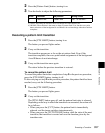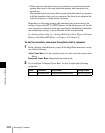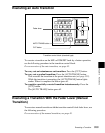
352
Executing a Transition
Chapter 3 Transitions
Setting the Transition Rate
There are two ways of setting the transition rate: using the Flexi Pad control
block or numeric keypad control block to enter a numeric value, or using the
Misc menu to access the Transition menu for the M/E or PGM/PST bank.
You can also display the transition rate, independent key transition rate, and
fade-to-black transition rate for each of the M/E and PGM/PST banks, and
change the settings. (See “Displaying a List of Transition Rates and Changing
the Settings” (page 553).)
Note
When a clip transition is selected as the transition type, it is not possible to set
the transition rate.
Frame input mode and timecode input mode
For numeric input of the transition rate value, there are two modes: frame input
mode and timecode input mode. You select one of these modes using either the
Flexi Pad control block (page 353) or the numeric keypad control block (page
354).
Frame input mode: The entered value is a number of frames.
Example: Entering 123 constitutes an entry of 123 frames
Timecode input mode: The entered value is a timecode value.
Example: Entering 123 constitutes an entry of 1 second 23 frames.
Note
Whereas you can enter a value of up to 999 in frame input mode, a value not
smaller than 10 seconds cannot be entered in timecode input mode.
Frame display mode and timecode display mode
For the transition rate display in the transition control block, there are two
modes: frame display mode and timecode display mode. You can select one of
these modes in setup. (See “Operation Settings” in Chapter 16 (Volume 2).)
Note
The setting is common to all banks of the switcher.
Frame display mode: Values are shown as from 0 to 999 frames. In this
display mode, a value entered in timecode input mode is converted for
display as a number of frames.
Timecode display mode: Values are shown as timecode values, consisting of
seconds and frames. In this display mode, a value entered in frame input



